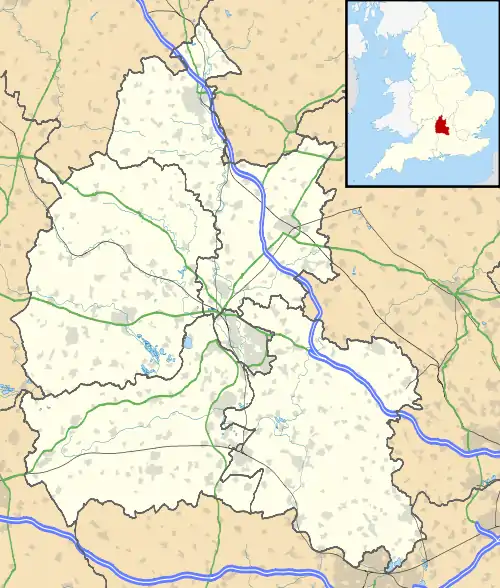Cote Baptist Church
Cote Baptist Church stands in Shifford Road, Cote, 1 mile (2 km) to the east of Aston and 4 miles (6 km) to the east of Bampton, in Oxfordshire, England. It is a redundant Baptist chapel in the care of the Historic Chapels Trust,[1] and is recorded in the National Heritage List for England as a designated Grade II* listed building.[2]
| Cote Baptist Church | |
|---|---|
 Entrance front of Cote Baptist Church | |
| Location | Cote, Oxfordshire, England |
| Coordinates | 51.7255°N 1.4930°W |
| OS grid reference | SP 351 031 |
| Founded | 1703 |
| Built | 1703–04 |
| Restored | 1750s, 1850s |
| Architectural style(s) | Georgian |
| Governing body | Historic Chapels Trust |
Listed Building – Grade II* | |
| Designated | 8 October 1981 |
 Location in Oxfordshire | |
Early history
The congregation of Baptists who built the chapel originated in Longworth, a village on the other side of the River Thames, in the middle of the 17th century. The land for a chapel in Cote was given by John Williams in 1703 and the chapel built on the land was licensed for meetings the following year.[3] In the 1750s it was either rebuilt or enlarged, and a gallery was added in 1756.[1] In the late 1850s the chapel was extensively restored, and the double gable at the front was replaced by a single gable, which hid the roof valley behind it. At the same time, the chapel was re-floored and the vestries were enlarged, new pews and galleries were added, and a new pulpit was placed at the west end which replaced the previous pulpit on the south wall. An organ by Henry Jones of London was added in 1867, and electric light was installed in 1948.[3] From 9 January 1945 until 25 June 1957 the Church was the home to the 1st Aston Boys' Brigade Company under the captainship of Alan J Hook.
Architecture, fittings and furniture
The chapel is constructed in limestone rubble and has a stone slate roof. It is in two storeys and its plan consists of a single cell with a single-storey extension. Its architectural style is Georgian. The entrance front has a flat-topped gable surmounted by a plaque with scrolls at each end. In the lower storey is a central window with a semicircular arch, which stands between two doors. In the upper storey and elsewhere in the building are windows in a similar style. All the internal fittings date from 1869, and include box pews with hinged doors and, at the west end, a pulpit with a panelled front, a reader's desk and a lectern.[2]
Recent history and present day
The chapel was taken over in 1993 by the Historic Chapels Trust. A restoration programme costing £250,000 was carried out and the building was reopened in 2000.[4] The restoration included the provision of a kitchen, toilets, and committee rooms. The building is available to hire for concerts, conferences and other events. It is licensed for weddings. The surrounding burial ground is unlocked and is available for public access.[1] The church community now meets in the Cote Fellowship Centre.[5]
External features
Around the chapel is a burial ground containing headstones, some of which date from the 18th century and are elaborately carved.[1] It contains the chest tomb of William Williams who died in 1830. This tomb is constructed in limestone and has corner balusters; it is a Grade II listed building.[6]
References
- Cote Baptist Chapel, Historic Chapels Trust, archived from the original on 15 July 2010, retrieved 1 July 2010
- Historic England, "Cote Baptist Church, Aston, Cote (1284460)", National Heritage List for England, retrieved 10 July 2013
- Crossley, Alan; Cuerry, C. R. J., eds. (1996), Bampton Hundred (Part One): Aston and Cote: Nonconformity, A History of the County of Oxford, vol. 13, University of London & History of Parliament Trust, pp. 77–78, retrieved 1 July 2010
- Woods, Mark (31 July 2008), "Sadness as historic chapel forced to close", The Baptist Times, Didcot: The Baptist Times, retrieved 1 July 2010
- Cote Fellowship Centre, Cote Baptist Church, archived from the original on 19 January 2019, retrieved 1 July 2010
- Historic England, "Chest Tomb east of Cote Baptist Church, Aston, Cote (1052470)", National Heritage List for England, retrieved 10 July 2013